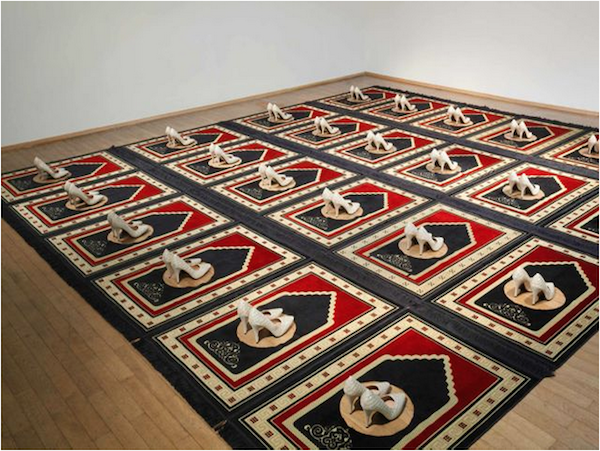
Courtesy: the artist © Zoulikha Bouabdellah
Days after the world stood up in support of freedom of speech following the Charlie Hebdo massacre, artist Zoulikha Bouabdellah was coerced into self-censorship for a piece featuring prayer rugs and high heels (see 12 Killed at Magazine Previously Attacked for Satirical Cartoons and Not Everyone Is Going To Agree: Deal With It).
Bouabdellah, who was born in Moscow and grew up in Algeria, was due to exhibit her installation Silence (2008) at a recently-opened show “Femina ou la Réappropriation des modèles” at the Pavillon Vendôme in Clichy, a suburb north of Paris.
But the day before the opening on January 24, she was told by one of the show’s co-curators, Christine Ollier, that the town hall had been in touch saying that a group “representing Muslims in Clichy had alerted the authorities to the possibility of a violent reaction provoked by the presence of the piece in the show.”
According to Bouabdellah, who spoke to artnet News from her home in Morocco, the Clichy officials showed no support for the exhibition.
The artist explained that her piece was inspired by a group of Muslim feminists she had come across in Morocco, that it is an homage to strong women in the Arab world─and in no way blasphemous.
“[But] since we were not supported by the mayor, the guarantor of the French Republic’s principles, I didn’t want to take the responsibility, so we decide to remove the work,” Bouabdellah said.
“Yes, it was self-censorship, I completely accept that,” she continued. “It was a real moral dilemma for me, and I thought, ‘I’m giving in,’ but on the other hand, I didn’t want the other pieces to be at risk or the show to close down.”
Orlan Condemns the Decision
Celebrated French performance artist Orlan took to Facebook to condemn the pressure to which Bouabdellah was subjected. “This act of self-censorship hides a more serious censorship,” she wrote in an open letter published on the social media platform on Sunday.
“While I understand the reasoning [that led the artist and curators to remove the piece], I cannot support it as it opens the doors to all kinds of insidious restrictions of our freedom of speech, risking that we progressively move, consciously or unconsciously, from self-censorship to self-silencing, and from self-silencing to an inhibition provoked by fear,” the letter continues.
Orlan also asked for her own contribution to the show, a 1977 self-portrait as Ingres’s Grande Odalisque, to be removed.
Orlan, ORLAN en Grande Odalisque d’Ingres (1977).
Photo: Copyright / Courtesy ORLAN – Galerie Michel Rein
“Once again, we’ll leave things in a state of conflict and ignorance, which will continue to widen the gap,” commented Bouabdellah. “This was the perfect opportunity to gather everybody and to start a conversation. The mayor of Clichy missed a real opportunity.”
Institutions have been particularly sensitive to anything that might be deemed offensive since the Paris attack. In London, the V&A Museum─described by one of its staff as “on a severe security alert”─ removed from its website the image of an artist-designed poster representing the Prophet Muhammad (see Security Threats Force London’s V&A to Remove Prophet Muhammad Artwork).
The Pavillon Vendôme did not respond to artnet News’ request for comment.